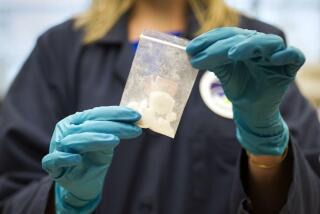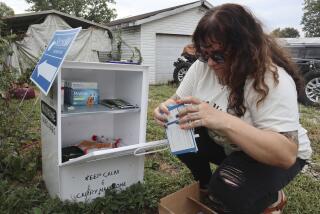Latest Tylenol Poisoning: A Nightmare Comes True
WHITE PLAINS, N.Y. — Joan Vogel could literally smell a crisis in the making.
Vogel, a toxicologist for Westchester County in suburban New York, is one of the scant 12% of the population who can readily recognize the telltale odor of the deadly poison cyanide.
On that Sunday morning, she was examining the bottle of Extra-Strength Tylenol capsules found in a Yonkers home where a seemingly healthy young woman had suddenly and inexplicably died the day before. As she popped off the bottle’s cap, Vogel was startled by the scent of bitter almonds.
“Oh no!” she thought. It was Chicago all over again.
Vogel’s sickening discovery on Feb. 9 touched off another nationwide scare that, like the seven Tylenol-poisoning deaths nearly four years earlier in Chicago, has raised disturbing questions about the vulnerability of over-the-counter medicines--indeed, of all consumer products--that Americans have come to regard as safe.
The crisis turned a period of economic buoyancy for Tylenol manufacturer Johnson & Johnson into one of corporate agony, and forced the company’s painful and costly decision to abandon production of all capsule medications.
And it prompted the entire drug industry to re-examine, once again, the integrity of its products.
“The main anguish that any human being feels is that, somehow and some way, after doing everything we knew how to do, there’s another person dead out there--and that our product was an instrument of that death, a murder weapon,” James E. Burke, chairman of Johnson & Johnson, said in an interview. “That is very painful for us.”
As a result of lessons learned from the Tylenol tragedy of nearly four years ago, federal authorities and Johnson & Johnson were able to respond instantly when they received confirmation that it was cyanide-contaminated Tylenol that had killed Diane Elsroth, a 23-year-old stenographer from Peekskill, N.Y.:
Response to Emergency
--New York regional employees of the Food and Drug Administration were dispatched almost immediately to the Bronxville, N.Y., neighborhood where the bottle was purchased, to collect samples of Tylenol from other stores.
Workers in the FDA’s Brooklyn lab quickly began the painstaking task of examining each package and opening thousands of capsules by hand, one at a time. Working around the clock in three shifts, they searched for other contaminated capsules.
--The FDA and the company issued a nationwide warning that consumers should avoid packages of Tylenol capsules from the same lot as the poisoned bottle.
--Johnson & Johnson immediately established a toll-free telephone line for worried consumers, and temporarily halted production, distribution and advertising of all Tylenol capsules.
--After a jurisdictional tug-of-war with local authorities that lasted several hours, FDA officials obtained half of one of the three remaining poisoned capsules, sealed it in a brown paper bag and sent it, with an FBI agent, on a Johnson & Johnson corporate jet to the FDA’s sophisticated lab in Cincinnati for a more intensive analysis.
At the lab, tests were performed to determine whether the poison was the same type of cyanide used in the still-unsolved Chicago killings. It was not.
Before the end of a very troubling 12 days, a second bottle containing poisoned Tylenol--its three package seals seemingly untouched--would be discovered, and nearly three-quarters of a million capsules would be scrutinized. The drug industry would reluctantly admit that it had no solution to the tampering problem, and authorities from the Yonkers police to the highest levels of the federal government would be more baffled than ever.
Tylenol Sales Were Up
The latest Tylenol-related death came at a time of soaring sales for Johnson & Johnson, which had struggled back from the 1982 disaster to rebuild its nearly shattered business. And it came during a period of uncertainty for the FDA, which, like other federal agencies, was operating under tough budget restrictions imposed by the new Gramm-Rudman budget-balancing law.
When the crisis broke, FDA Commissioner Frank E. Young, back in Washington from a trip to Switzerland, had just begun meeting with worried agency employees to reassure them that their ranks would not be further depleted. He would spend the next week dividing his time between the capital--where he would be preoccupied with Tylenol--and Philadelphia, where his mother, suffering from cancer, was clinging to life in a hospice.
On Friday--the day before Elsroth died--Johnson & Johnson executives had heard jubilant economic news at their corporate headquarters in New Brunswick, N.J., 30 miles from New York: The company had captured the largest share ever of the painkiller market. There was good reason to celebrate, but Chairman Burke was worried. Things were going almost too well.
Scenario of Tragedy
On that same snowy Friday in February, Elsroth and her boyfriend, Michael Notarnicola, spent the evening as they often did, in the comfortable, split-level Yonkers home of his parents, according to authorities. Investigators say that Notarnicola’s mother and father, who own a beauty salon, were “crazy about” Elsroth. The two had been dating for about three years and were unofficially engaged.
They watched television in the ground-floor den until after midnight. At about 1 a.m., Elsroth complained that she wasn’t feeling well. Notarnicola, knowing that his mother was an inveterate user of Tylenol, went upstairs to her medicine cabinet. His girlfriend took two of the Extra-Strength capsules and went to bed.
At 1:34 p.m. the next day, Yonkers police received a call from the Notarnicola home. Diane Elsroth was dead.
A coroner performed an autopsy but could not determine the cause of death. Like many medical examiners whose dulled senses of smell enable them to perform their jobs without the predictable unpleasant side effects, he could not detect the characteristic odor of cyanide.
It was not until the next day, when the bottle and the body were turned over to toxicologist Vogel, that the connection was made. When she tested the contents of Elsroth’s stomach the laboratory solution turned blue, indicating the presence of cyanide.
Traced Through Trash
Meanwhile, police had retrieved the bottle’s outer cardboard package and the sales slip showing that the bottle had been purchased from a Bronxville A&P; market. The Notarnicolas own a trash compactor and routinely stored trash for several days at a time. This yielded valuable information--the place and date of purchase--and allowed investigators to examine the containers for evidence of tampering.
‘We’re in Deep Trouble’
On the same Saturday that Elsroth died, Johnson & Johnson Chairman Burke spent a restless night. He dreamed that the still-unsolved Chicago disaster was happening all over again. On Monday afternoon, an ashen-faced associate entered his 11th-floor office and Burke learned that his nightmare was only beginning.
“Jim,” said David Clare, president of the company, “we’re in deep trouble.”
Burke, recalling the exchange, said last week: “We’ve had scares before, lots of them. So, even as he told me that, we were both hoping against hope that perhaps this was another one. But then it became painfully clear that it was not.”
Throughout the week, FDA field agents scoured Yonkers and outlying areas, collecting samples, enlarging the circle from the Bronxville A&P; to other A&P; markets and to other stores in the county. They continued to send everything to the agency’s Brooklyn lab.
‘Crisis Team’ Convened
In New Brunswick, a Johnson & Johnson “crisis team” of high-level corporate executives began to meet every day. It was decided early on, corporate Vice President Lawrence Foster said, “to be completely open.”
At one point during those early days, Burke sat down and wrote a personal letter to Elsroth’s family.
“I didn’t attempt to call, because I didn’t think they would find it a particularly helpful thing,” he said. “I just tried to express my sympathies as best I could. Diane’s mother has said that when we took the capsules off (the market)--that we took them off three years too late, and I don’t blame her for saying that. I would too.
“It’s so easy to identify when you think about your own family,” he added. “That’s very hard for us to take emotionally. That adds to the burden. That’s the nightmare.”
After several days, everyone involved in the case was beginning to feel a measure of relief: Elsroth’s death appeared to have been an isolated incident.
Then on Thursday afternoon, Byron Tart, an FDA consumer safety officer at the Brooklyn lab, picked up a package of Tylenol. He examined it for signs of tampering. There were none. The outer package flap was glued shut. The inner seals were intact.
He opened the bottle.
The capsules seemed misaligned. The capsule half that was usually white was yellowish-brown instead. Tart opened a capsule and sniffed.
Bitter almond.
Second Bottle Identified
Within two hours, Burke received a telephone call from Young: “Jim, are you sitting down?” Young asked. “We’ve found a second bottle.”
This package, taken from a Woolworth’s store less than two blocks from the A&P;, came from a different lot and was manufactured in a different plant. The discovery was deflating and frightening to everyone involved.
“All of a sudden, it was clear that whoever did the first tampering was willing to have more people die,” John A. Norris, FDA deputy commissioner, said last week. “He was willing to kill more than once. The dimensions changed dramatically.”
The FDA, anxious to warn the public not to take Tylenol capsules of any kind, drafted a statement and began calling reporters. The FDA commissioner, short of staff, sat down and began dialing the phone and reading reporters his own press release.
At the same time, preparations were made to fly the latest sample to Cincinnati, to determine if the cyanide matched the poison that killed Elsroth. The Johnson & Johnson corporate jet was not available, so the agency arranged for a commercial flight scheduled to leave New York at 10 p.m. They hoped to get preliminary results of analysis by midnight.
But the flight was delayed two hours by bad weather in New York. It was 2 a.m. when chief chemist Fred Fricke called the agency from Cincinnati to report that the two samples were the same, and it was nearly 5 a.m. when the finding was confirmed.
Chairman Calls Meeting
Throughout the weekend, company executives gathered in Burke’s office, luxurious quarters with expansive glass windows overlooking the Raritan River.
Some argued that the company should stop producing capsules, that the public would never feel they were safe after this second incident. But those who had helped to rebuild Tylenol sales after the 1982 deaths argued, just as strenuously, that they should continue.
Burke listened, but said little, according to those who attended the meeting. The following Monday, he announced that Johnson & Johnson was out of the capsule business.
The investigation continues. The FBI, which has refused to discuss the case, has said only that it is “unlikely” the contamination occurred during the manufacturing process. Johnson & Johnson and the FDA agree. They note that the two poisoned bottles were found less than two blocks apart.
But how did it happen? Who did it? And why?
Four years after Chicago, there are still no answers.
More to Read
Sign up for Essential California
The most important California stories and recommendations in your inbox every morning.
You may occasionally receive promotional content from the Los Angeles Times.










